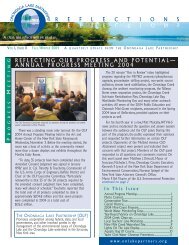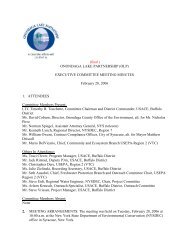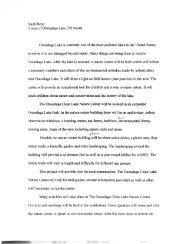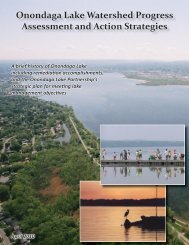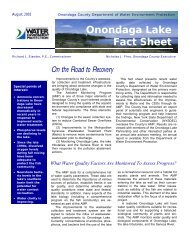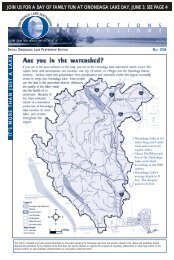Habitat Plan 2 - Onondaga Lake Partnership
Habitat Plan 2 - Onondaga Lake Partnership
Habitat Plan 2 - Onondaga Lake Partnership
Create successful ePaper yourself
Turn your PDF publications into a flip-book with our unique Google optimized e-Paper software.
DRAFTPhotograph of SWY-6 taken in earlyspringtime from the trail along thesouthern shoreline of <strong>Onondaga</strong> <strong>Lake</strong>mercury, nickel, selenium, thallium, vanadium and zinc.Hexachlorobenzene, total polycyclic aromatic hydrocarbons (PAHs),total PCBs, 4,4-DDT, and PCDD/PCDFs were also detected.These contaminated areas are being addressed by the Ninemile Creekremedy.Wetland SYW-6Wetland SYW-6, located at the northwest border of <strong>Onondaga</strong> <strong>Lake</strong>, isa 100-acre, Class I wetland. This property is owned by <strong>Onondaga</strong>County and the wetland is situated between I-690 and <strong>Onondaga</strong> <strong>Lake</strong>.This wetland is divided by a series of elevated berms which are typicallyused as biking and walking paths, but are large enough to supportvehicles. The paths create cells in the wetland that are not connectedby surface flows, though some are hydrologically connected to eachother by culverts. Some portions of this wetland are directly connectedto the lake through culverts under the paths. The cells in the wetlandvary in vegetation type, but are dominated by floodplain forest oremergent wetland species. Two jurisdictional wetland delineations havebeen performed at portions of Wetland SYW-6.Barton and Loguidice (B&L) Consulting Engineers, on behalf of the<strong>Onondaga</strong> County DOT, performed a jurisdictional wetland boundarydelineation of Wetland SYW-6 in October 2000 (B&L, 2001). Thewetland delineation effort focused on those areas associated with the<strong>Onondaga</strong> <strong>Lake</strong> west trail improvement project, including the existingpedestrian trail (Paved Trail), secondary trail (Nature Trail), and culverts.Both forested and emergent wetlands were mapped as part of thiseffort. The forested wetland was dominated by eastern cottonwood andcommon buckthorn with occasional red maple (Acer rubrum) and greenash. The emergent wetlands were vegetated with Phragmites, narrowleavedcattail (Typha angustifolia), and common cattail (Typha latifolia).The berm banks were typically vegetated with common buckthorn andsome staghorn sumac (Rhus typhina). The boundary of the entirewetland system was not delineated beyond the project areas, althoughthe wetland cell boundaries are generally defined by the berms.O’Brien & Gere, on behalf of Honeywell, also performed a jurisdictionalwetland delineation at a portion of Wetland SYW-6 as part of thewetland/floodplain assessment previously discussed. This wetlandsection is located along the northwest lake shoreline between a pavedportion of the <strong>Onondaga</strong> <strong>Lake</strong> trail system and the lakeshore.SYW-6 is approximately 5.5-acres, based on the wetland boundarydelineation. <strong>Onondaga</strong> <strong>Lake</strong> forms the eastern and southern borders,and an abrupt rise in topography associated with the lake trail definesthe western and northern borders of the wetland. This wetland ispredominantly forested floodplain with some smaller stands ofPhragmites along the immediate lakeshore. The forested floodplainportion is approximately 3 to 4 acres and is composed of an overstory ofpredominantly silver maple, cottonwood, green ash, American elm andswamp white oak (Quercus bicolor). The remainder of this wetlandconsists of a narrow strip of deciduous trees and shrubs (American elm,green ash, cottonwood and buckthorn) along the lakeshore. ThePARSONS | Remedial Design Elements for <strong>Habitat</strong> Restoration 51



